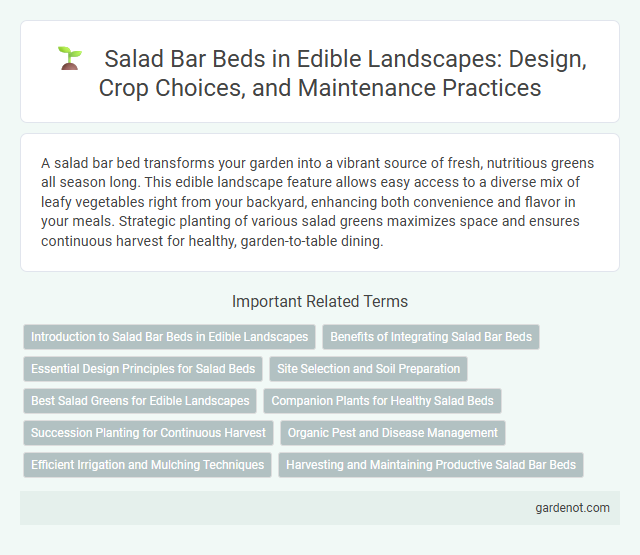A salad bar bed transforms your garden into a vibrant source of fresh, nutritious greens all season long. This edible landscape feature allows easy access to a diverse mix of leafy vegetables right from your backyard, enhancing both convenience and flavor in your meals. Strategic planting of various salad greens maximizes space and ensures continuous harvest for healthy, garden-to-table dining.
Introduction to Salad Bar Beds in Edible Landscapes
Salad bar beds in edible landscapes integrate a diverse array of leafy greens, herbs, and edible flowers within compact, visually appealing garden plots designed for easy harvesting. These beds maximize space efficiency and promote continuous production of nutrient-rich, fresh ingredients, enhancing both culinary use and garden aesthetics. Strategic layering and companion planting techniques improve soil health and reduce pests, creating sustainable, low-maintenance salad bar beds.
Benefits of Integrating Salad Bar Beds
Salad bar beds enhance home gardens by providing a continuous supply of fresh, nutrient-rich greens, promoting healthier eating habits. They optimize space efficiency and reduce grocery expenses by growing diverse salad ingredients in one accessible area. Incorporating salad bar beds supports sustainable living through organic cultivation and minimizes food waste with on-demand harvesting.
Essential Design Principles for Salad Beds
Salad bar beds thrive on essential design principles such as soil quality, moisture retention, and optimal plant spacing to enhance yield and flavor. Incorporating diverse leafy greens with compatible growth habits maximizes space and nutrient use while promoting continuous harvest. Sunlight exposure and organic mulching further support healthy, pest-resistant crops, ensuring a vibrant edible landscape.
Site Selection and Soil Preparation
Site selection for a salad bar bed requires well-drained soil with a pH level between 6.0 and 7.5, ensuring optimal nutrient availability and root development. Preparing the soil involves tilling to a depth of 8-12 inches, incorporating organic matter such as compost to enhance fertility and moisture retention. Choosing a location with full sun exposure--at least 6 hours daily--promotes vigorous growth of leafy greens and herbs.
Best Salad Greens for Edible Landscapes
Salad bar beds thrive when planted with nutrient-rich greens like arugula, spinach, and kale, which provide robust flavors and high yields in edible landscapes. These salad greens are not only visually appealing but also resilient, offering continuous harvests throughout the growing season. Incorporating a mix of mustard greens and Swiss chard enhances diversity, maximizing both aesthetic value and nutritional benefits in sustainable edible design.
Companion Plants for Healthy Salad Beds
Companion plants such as basil, chives, and marigolds enhance the health of salad bar beds by naturally repelling pests and attracting beneficial insects. Growing lettuce alongside radishes and carrots improves soil aeration and nutrient availability, promoting vigorous growth. Integrating herbs like dill and cilantro supports biodiversity, reduces disease risk, and boosts overall salad bed productivity.
Succession Planting for Continuous Harvest
Succession planting in a salad bar bed maximizes continuous harvest by staggering the sowing of leafy greens and herbs every two to three weeks. Fast-growing crops like lettuce, arugula, and spinach thrive in this system, ensuring a steady supply of fresh produce throughout the growing season. Proper spacing and timely thinning boost airflow and reduce pest issues, promoting healthier, more productive plants for ongoing salad harvests.
Organic Pest and Disease Management
Salad bar beds benefit from organic pest and disease management techniques such as introducing beneficial insects like ladybugs and lacewings to control aphids and other pests naturally. Applying neem oil or insecticidal soaps helps suppress fungal diseases while preserving beneficial organisms in the soil. Crop rotation and companion planting within the edible landscape reduce pest buildup and enhance plant resilience without synthetic chemicals.
Efficient Irrigation and Mulching Techniques
Salad bar beds enhance plant health through efficient irrigation methods such as drip systems that deliver precise moisture directly to roots, minimizing water waste. Mulching with organic materials like straw or wood chips preserves soil moisture, suppresses weeds, and regulates temperature, promoting consistent growth in leafy greens. These techniques combined increase water use efficiency and ensure a sustainable, productive edible landscape.
Harvesting and Maintaining Productive Salad Bar Beds
Harvesting salad bar beds requires regular, selective cutting of leaves and herbs to encourage continuous growth and prevent bolting. Maintaining productive beds involves consistent watering, balanced fertilization with organic compost, and controlling pests using integrated pest management techniques. Rotating crops and incorporating companion planting enhance soil health and maximize yield throughout the growing season.
Salad bar bed Infographic

 gardenot.com
gardenot.com